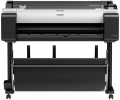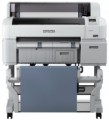Paper size
The paper size the plotter is designed to operate with. Most models use ISO 216 formats, identified by the letter A followed by a digit. These formats include the popular A4, but plotters usually work with larger paper:
- A0+. This marking means that the plotter is able to work with sheets larger than A0 (see below). The A0+ format itself provides a sheet width of 914 mm, however, in this case, support for wider media is usually provided — about 1100 mm (1050 – 1150 mm) in the most modest models of this format ( A0+ 44 ") and 1500 mm or more in the largest ( A0+ ≥ 60")
- A0. Paper of this format has a size of 1189x841 mm.
- A1. Paper size 841x594 mm — in other words, half of the A0 format.
- A2. A sheet of this format is approximately the size of a newspaper spread — 420x594 mm, half the size of A1. Considered relatively small by plotter standards.
- A3. The smallest format found in modern plotters: 297x420 mm, that is, only twice the standard A4 (in other words, with a magazine spread). Used in few desktop models (see Installation) — particularly, textile devices (see Product Type) for printing on T-shirts and other similarly sized clothes.
It is also worth noting that many models are able to work with other sizes. Moreover, we are talking not only about reduced, but also about la
...rger options: the maximum media width (see below) often exceeds the standard paper size.Max resolution
The highest image resolution the plotter is capable of printing on paper. It is indicated by the number of dots per inch horizontally and vertically — for example, 1440x720.
The higher the resolution, the smoother the printed image will be as a result, the less noticeable individual dots will be on it (to the point that they cannot be seen at all with the naked eye). On the other hand, the ability to print in such resolutions affects the price of the plotter accordingly. In addition, do not forget that high-quality printing requires appropriate source materials — the quality of the print cannot be higher than the quality of the original image.
Note that in this case we are talking about the maximum resolution; usually in the settings it is possible to set more modest parameters.
Sheet printing time
Approximate time taken by the plotter to print one sheet.
This indicates for the paper size that the machine was originally designed for (see "Paper Size"). And it is approximate because it is usually given for optimal or almost optimal printing conditions: low quality and resolution, relatively simple images, etc. So the actual print time of the sheet may differ from the claimed one in one direction or another, depending on the operating parameters — starting from the mentioned quality and resolution to the type of media. However, according to the figures indicated in the specs, it is quite possible to evaluate different models and compare them with each other: the difference in the claimed time, usually, will proportionally correspond to the difference in the actual printing speed.
It is also worth noting that this time is usually indicated by the duration of the printing process itself — from the capture of the sheet by the feeder to the output of the completed print from the device. Interruptions inevitably occur between printing individual sheets, so that the total printing time is longer than the printing time of a sheet multiplied by the number of sheets. For example, a device with a time consumption of 36 sec per sheet theoretically should print about 100 sheets per hour (1 h = 3600 s, 3600/36 = 100), but in fact such a plotter usually produces about 70 – 75 sheets in this time.
Drop volume
The smallest drop volume of ink that can be produced by the printhead of an inkjet or similar plotter (see "Product Type").
This parameter is directly related to the print resolution (see “Maximum resolution”): the more dots per inch, the smaller the separate dots and, accordingly, the drops should be. At the same time, models with the same dpi number may differ slightly in this parameter. In such cases, it should be assumed that a smaller droplet volume potentially provides better print quality, with more accurate reproduction of fine lines and borders between individual areas of the image, however, such features accordingly affect the price of the device.
Media width (min)
The smallest width of paper or other media that the plotter can handle. Such devices, by definition, are designed for large-format printing and are poorly suited for small media; therefore, if you plan to frequently print on sizes smaller than standard (see "Paper Size"), you should pay attention to this parameter and make sure that the selected plotter can work with all the necessary materials.
Media width (max)
The largest width of paper or other media that the plotter can handle. The larger this parameter, the larger the materials that can be printed on the device; however, the dimensions, weight and cost of the plotter also increase markedly due to this.
Data transfer
Data transfer supported by the plotter.
In addition to direct
connection to a PC via USB, supported by the vast majority of such devices, connection to PC network is very popular nowadays — usually via a wired
LAN port, and often via
Wi-Fi. The last one may additionally support special modes of operation —
Wi-Fi Direct and/or
. You can also find plotters with support of external media — in the form of a card reader or its own
USB port for flash drives.
Here is a more detailed description of each of these options:
— Connection to a PC (USB). Connecting to a standard USB port on a PC or laptop is a classic data transfer format found in almost all modern plotters. It allows you to send print tasks to the device, manage settings, receive various operation notifications on your PC, save digitized materials from the built-in scanner (if available — see above), etc. The disadvantages of this connection include the fact that it is designed for interaction between the plotter and only one specific PC. Anyway, you can also manage a network sharing on this PC — but this is quite complicated; it is easier to immediately select a device with network connectivity (see below).
— Network connection (LAN)
.... LAN connection via wired LAN interface. By itself, network connectivity at least makes the plotter accessible from any PC on the local network; and some models even allow to be used over the Internet. In addition, such devices may provide various specific network functions — for example, sending materials from a scanner to file storage or e-mail. A wired connection is not as convenient as Wi-Fi — in fact, because of the need to run a wire — but it is cheaper, and it also provides a more stable and reliable connection, not dependent on obstacles and interference levels near the device.
— USB (for flash drives). USB port for connecting various external media, installed in the plotter. In addition to flash drives, this connector can be used for external HDDs, as well as for cameras and many other portable devices with built-in storage. In any case, such a connection is mainly used for direct printing — sending files for printing without using a PC. And if you have a scanner (see above), you can also copy scanned materials to an external device via the USB port. Navigation through the contents of external media is usually carried out using the display installed on the plotter.
— Card reader. Built-in memory card reader — most often SD format (although specific types and volumes of supported cards should be clarified separately, since the SD standard covers several subspecies of media). The use of this function is generally similar to the USB port for flash drives described above — it makes it possible to print files directly from external media, as well as save data received from the scanner (if available) to this media. Memory cards are now supported in many types of electronic devices — in particular, laptops are almost always equipped with card readers, and in digital cameras this type of media is used as a standard for saving footage. Accordingly, the presence of a card reader in the plotter facilitates data exchange with such equipment: removing and inserting a card is often easier than copying materials to a computer or fiddling with a direct USB connection (if it is available at all).
— WiFi. The presence of its own Wi-Fi module allows the plotter to connect to PC network, as well as use special features such as Wi-Fi Direct and Airprint. See below for such features; as for the network connection, it provides all the same features as the wired LAN standard described above. At the same time, a Wi-Fi connection is much more convenient, as it allows you to do without laying cables. True, such a connection is somewhat more expensive, besides, the data transfer rate may drop with an abundance of interference; however, for plotters, the last one is most often not critical, and the price of a Wi-Fi module is often insignificant compared to the price of the entire device. So most modern network models support not only wired, but also wireless connections.
Specifications may also specify the Wi-Fi standard used by the device; most often it is Wi-Fi 4 or Wi-Fi 5. However, the difference between these standards in this case is not fundamental: both of them provide sufficient speed for functions implemented in plotters, and modern wireless equipment usually provides compatibility with all major Wi-Fi standards .
— WiFi Direct. A feature found on models with built-in Wi-Fi modules (see above). Direct support allows you to connect other Wi-Fi devices (laptops, smartphones, cameras, etc.) to such a plotter directly, without using a router and a local network. This can be especially convenient if there is no network equipment, or if it needs to be additionally configured. The set of functions available with this connection includes, at least, sending materials to print; however, control of plotter settings and other more specific features may also be provided.
— AirPrint. Wireless direct printing technology found on Apple devices such as iPhones, iPads, MacBooks, and more. AirPrint printing is convenient and simple—it requires no additional setup when connected to a plotter and can be done with just one touch ". In this case, communication with the printing device is carried out via Wi-Fi directly — similar to the Wi-Fi Direct described above (in fact, AirPrint is usually provided as an addition to this mode).Cartridge model
Models of cartridges used in the plotter. With this info, you can easily find original consumables for the device.
Built-in memory
The amount of built-in memory provided in the design of the plotter.
Such memory is used to store various service data: print tasks, settings profiles, etc. Due to this, the plotter becomes more "independent": for example, many models allow you to continue printing even when the master PC is turned off.
We emphasize that in this case we are talking about solid-state flash memory, which is used mainly for "operational" service information. The capacity of such memory is relatively low, it is measured in megabytes; but in addition to it, the design may include a larger storage capacity — usually a traditional hard drive. For more information about it, see "Drive Capacity".

